Publication Information
ISSN: 2641-6816
Frequency: Continuous
Format: PDF and HTML
Versions: Online (Open Access)
Year first Published: 2018
Language: English
| Journal Menu |
| Editorial Board |
| Reviewer Board |
| Articles |
| Open Access |
| Special Issue Proposals |
| Guidelines for Authors |
| Guidelines for Editors |
| Guidelines for Reviewers |
| Membership |
| Fee and Guidelines |
 |
Dietary Consumption and Cancer Prevention
Fatima Irfan*
*Department of Diet and Nutritional Sciences, The University of Lahore, Pakistan
Received Date: 09 May, 2019; Accepted Date: 23 May, 2019; Published Date: 29 May, 2019
*Corresponding Author: Fatima Irfan, Department of Diet and Nutritional Sciences, The University of Lahore, Lahore, Pakistan. Tel: +923008433627; Email: fatimairfantajamul@gmail.com
Citation: Irfan F (2019) Dietary Consumption and Cancer Prevention. Adv Nutri and Food Sci: ANAFS-132.
Abstract
Cancer is applied to large group of diseases characterized by multiplication of abnormal cells, caused by the changes in genes in DNA. Some cancer may eventually spread and reside into other tissues, affecting almost any part of the body. There are more than 200 types of cancers, carcinoma, leukemia, lymphoma to name a few. According to WHO 9.6 million people were estimated to die from cancer in 2018, making it as the second leading cause of mortality globally. Deaths from cancer worldwide are projected to reach over 13 million in 2030, accounting for 45% between 2008-2030. Another study at WHO, 70% of deaths from cancer occur in low and middle-income countries. 30-50% or one third of all cancer demise could be minimized and prevented by avoiding key risk factors, implementing dietary and lifestyle modifications. Healthy changes such as consuming and adapting a balanced diet, including fruits and vegetables, high consumption of fiber, salt preserved foods, reducing smoking and alcohol, taking vitamins and minerals can translate and transform life. Herbs and natural products such as anti-oxidants, flavones, omega-3 fatty acids, carotenoids and vitamins provides substantial therapeutic value in cancer as well as several diseases. Cancer harms virtually every aspect of health and life. Healthy living is not cast-iron guarantee against cancer, but the odds are in the favor of reducing and pressing pause of developing risks.
Introduction
Cancer is the catchall term applied to a genetic disease that is caused by changes in the genes producing uncontrolled cell division and growth. Cancer isn’t one disease. It is many different diseases, more than 100 and counting.1 in 2 people in UK is at risk of getting the disease in their lifetime.
 Figure 1: Cancerous cell.
Figure 1: Cancerous cell.
There Are Several Types of Cancer
- Carcinoma- most common among all, formed by epithelial cells.
- Sarcomas- formed in bone and soft tissues.
- Leukemias- in blood forming tissue of bone marrow.
- Lymphomas- begin in lymphocytes (B and T cells). Abnormal lymphocytes are produced and build up in the lymph nodes and vessel.
- Melanoma- cancer in the specialized cells that make melanin. Most of the melanomas are formed on the skin but some can show occurrence in the pigmented tissues (Figure 2).

Figure 2: Types of cancer.
Phases of Carcinogenesis
 Figure 3: Phases of cancer.
Figure 3: Phases of cancer.
Etiology
- Tobacco
- Alcohol consumption
- Unhealthy diet with low fruit and vegetable intake
- Physical inactivity
- High consumption of sugar
- Excessive red and processed meat intake
- Infections by hepatitis or other carcinogenic infection
- Overweight or obese
- Urban air pollution
- Sexually transmitted HPV- infection
- Ultra violet radiations
- Chemicals
Tobacco use is the single most important risk factor for cancer and is responsible for approximately 22% of cancer-related deaths globally. Tobacco smoke contains numerous of known carcinogens. Causing lung, breast, colorectal, blood, bladder, liver, mouth, pancreatic and stomach cancer. Passive smoking also increases the risk of lung cancer and is particularly dangerous for children.
Alcohol increases the risk of mouth, pharynx, liver, breast, esophagus and colorectal. Ethanol in alcohol is a carcinogen damaging DNA, hindering absorption of folate and helping carcinogen enter into cells.
Fat cells produce extra hormones and growth factors. Hormones and growth factors signal the cells of the body to divide more often at a faster rate increasing the chances of cancer cells produced which can then continue to divide and form tumor.
According to a study conducted at American Institute for Cancer Research, consumption of more than 18 ounces of red meat (lamb, pork and beef) per week increases the risk of colorectal cancer. Red meat contains chemicals and compound such as haem that inflame and damage the lining of the gut producing harmful chemicals by bacteria. Processed meat eaten regularly with increased size portion also leads to both colorectal and stomach cancer. Chemicals called nitrates and nitrites are often used to preserve processed meat. In the body nitrites can be converted into cancer-causing chemicals called N-nitroso compounds (NOCs). The presence of these chemicals in processed meat increases the risk of cancer more than red meat. Intake of high sugar content, elevates calories in the body contributing to excess weight gain and body fats. Glucose is a major component for growing cancerous cells (Figure 4).

Figure 4: Recommendation on Processed Meat.
Almost one fifth of cancer in the world is reported to be caused by bacteria, virus or parasitic infections. The most commonly associated with an increased cancer risk are human papilloma virus (HPV), hepatitis B (HBV) and C (HCV) and the bacterium Helicobacter pylori (H pylori). HPV, a common infection can lead to cancer of cervical and anal. It is spread through close skin-to-skin contact, usually during sexual activity. Using a barrier method of contraception reduces the risk. HBV and HCV causes liver cancer as blood and other bodily fluids are passed mostly through sexual activity or sharing needles to inject drugs. H pylori is a type of bacteria found in the layers of human stomach. It is spread through contaminated water, food and mouth to mouth contact enhancing stomach ulcers as well as cancer risks.
Lack of physical exercise and poor choices of food, high demand of convenience and processed foods disrupts the metabolism of the body. It increases fat stores, deficiency of vitamins and minerals in the body thus contributing to an increase in free radicals later transforming the body healthy cells into cancerous ones.
Global Prevalence of Cancer
- According to a study, more than 500,000 cancer deaths occur in the U.S each year
- Overweight and obesity causes 6% of cancer cases in the UK.
- Approximately 70% of deaths from cancer occur in low- and middle-income countries.
- About 16% of people die from cancer
- Deaths from cancer worldwide are projected to reach over 13 million in 2030.
- It is projected that by 2030, between 10 and 11 million cancers will be diagnosed each year in low- and middle-income countries.
- Europe accounts for 23.4% of the global cancer cases
- America accounts for 21% incidence and 14.4% of mortality
- Africa contributes to 7.3% deaths from cancer
- The proportion of incidence cases in Asia is 48.4%, while the death toll is 57.3%.
Prevention and Treatment through Medical Nutrition Therapy (MNT) (Figure 5):
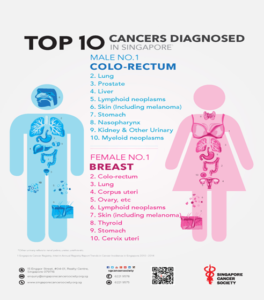
Figure 5: Most prevalent cancers among men and women in Singapore.
To avoid, prevent and delay the onset of cancers in body, an approach to natural products and healthy dietary practice is required. Best protection of cancer may be a dietary pattern that emphasizes on fruits, vegetables grains, beans and lentils. A road to modified and healthy dietary patterns, increased physical activity can not only transform the lifestyle but minimize the risk factors of the disease (Figure 6).
A healthy diet is about balancing the different foods and choosing foods that are tasty as well as nutritious.
- Aim for at least 5 portions of fruit and vegetables each day. They can be fresh, frozen or dried.
- A range of different colors of fruit and vegetables which would provide a variety of vitamins and minerals.
- Choose wholegrain versions of cereals, bread and pasta.
- Beans, lentils and peas are low-fat alternative to meat.
- Limit the amount of high calorie food intake such as chocolate, cake and fizzy drinks.
- Avoid or reduce processed meat in diet such as ham, bacon, sausage, salami and pepperoni.
- Limit the amount of red and processed meat to between 700 to 750 grams raw meat per week. This is equal to 500 grams of cooked meat per week or about 70 grams of cooked meat per day.
- Choose lean or white meat.
- Limit saturated fats found in foods such as fatty meat, biscuits, crisps, cheese, cream and butter.
- Use of unsaturated fats like vegetable, olive and sunflower oil is recommended.
Eating a Well-Balanced Diet Helps You To
- Recover from treatment
- Feel better
- Feel more in control
- Maintain healthy weight
Daily Protein Requirements for Patients with Cancer
- RDA for adults: 0.8g/kg
- Normal maintenance: 0.8 to 1 g/kg
- Non-stressed cancer patient: 1 to 1.2 g/kg
- Hyper-catabolic cancer patients: 1.2 to 1.6 g/kg
- Severely stressed cancer patient: 1.5 to 2.5 g/kg
- Hematopoietic stem cell transplant patient: 1.5 to 2 g/kg
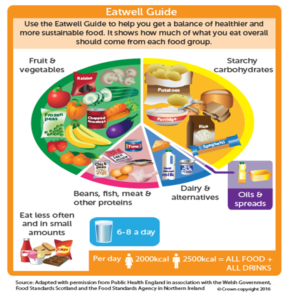
Figure 6: My happy plate.
Fruits and Vegetables Link With Cancer
Some fruits and vegetables have properties that can block the cancer cell growth. The phytochemicals and compounds found in fruits also hinder the replication of uncontrolled cell division and prevents growth of few damaged cells.
Pomegranate (Figure 7) contains ellagitannins, a compound that blocks the action of enzyme called aromatase. Aromatase plays a role in growth of some forms of breast cancer by helping the body produce the female sex hormone known as estrogen.

Figure 7: Pomegranate.
Broccoli, cauliflower and cabbage contains a compound called I3C. A chemical called genistein found in soy beans. Both, I3C and genistein, increase the level of vital DNA repair protein in cells. The repair protein, regulated by genes BRCA1 and BRCA2 are important for preventing damaged genetic information being passed on to the next generation of cells. People with faulty BRCA gene are at a higher risk of developing fewer forms of cancer, including breast, ovarian and prostate cancer. Since decreased amounts of the BRCA proteins are seen in cancer cells, higher levels might prevent cancer developing. The ability and function of I3C and genistein is to boost the amount of BRCA proteins.
Tomatoes (Figure 8) contains carotenoids that lowers the risk of cancer. Lycopene a carotenoid which has antioxidant properties appears to prevent DNA and other cell damage. It also stimulates self-destruction and decreases growth and metastasis of several types of cancer cells. Lycopene has a property to protect against prostate cancer.

Figure 8: Fresh tomatoes.
Apples are fruits rich in fiber. Flavonoids such as quercetin andtriterpenoids found in apples have slowed the development of cancers of the colon, lung and breast in several stages of cancer development.
Relationship of Phytochemicals and Cancer
Phytochemicals are naturally occurring plant chemicals which provide plants with color, odor and flavor. Phytochemicals have the properties and potential to:
- Stimulate the immune system.
- Block substances from becoming carcinogens.
- Reduce inflammation that increases the cancer growth.
- Prevent DNA damage and help with DNA repair.
- Reduce oxidative damage to cells that can spark cancer.
- Slow the growth rate of cancer cells.
- Trigger damaged cells to commit suicide before they can reproduce.
- Help to regulate hormones in the body.
To achieve the maximum health benefits of phytochemicals, it is advised to eat a varied diet highly consisting of vegetables, fruits, whole grains and beans. It is recommended to use brightly colored or strongly flavored vegetables and fruits, as they are often the best sources of phytochemicals (Table 1).
Color Code System of Fruits and Vegetables
Color
Phytochemicals
Vegetables and Fruits
Red
Lycopene
Tomatoes and tomato product, pink grapefruit, watermelon
Red/Purple
Anthocyanins, polyphenols
Berries, grapes, red wine, prunes
Orange
a-, b-carotene
Carrots, mangoes, pumpkin
Orange/Yellow
b-cryptoxanthin, flavonoids
Cantaloupe, peaches, oranges, papaya
Yellow/Green
Lutein, Zeaxanthin
Spinach, avocado, turnip greens
Green
Sulforaphanes, indoles
Cabbage, broccoli, cauliflower
White/Green
Allyl sulphides
Leeks, onion, garlic
Phytochemical(s)
Plant Source
Possible Benefits
Carotenoids
(such as beta-carotene, lycopene, lutein, zeaxanthin)Red, orange and green fruits and vegetables including broccoli, carrots, cooked tomatoes, leafy greens, sweet potatoes, winter squash, apricots, cantaloupe, oranges and watermelon
May inhibit cancer cell growth, work as antioxidants and improve immune response
Flavonoids
(such as anthocyanins and quercetin)Apples, citrus fruits, onions, soybeans and soy products (tofu, soy milk, edamame, etc.), coffee and tea
May inhibit inflammation and tumor growth; may aid immunity and boost production of detoxifying enzymes in the body
Indoles and Glucosinolates
(sulforaphane)Cruciferous vegetables (broccoli, cabbage, collard greens, kale, cauliflower and Brussels sprouts)
May induce detoxification of carcinogens, limit production of cancer-related hormones, block carcinogens and prevent tumor growth
Inositol
(phytic acid)Bran from corn, oats, rice, rye and wheat, nuts, soybeans and soy products (tofu, soy milk, edamame, etc.)
May retard cell growth and work as antioxidant
Isoflavones
(daidzein and genistein)Soybeans and soy products (tofu, soy milk, edamame, etc.)
May inhibit tumor growth, limit production of cancer-related hormones and generally work as antioxidant
Isothiocyanates
Cruciferous vegetables (broccoli, cabbage, collard greens, kale, cauliflower and Brussels sprouts)
May induce detoxification of carcinogens, block tumor growth and work as antioxidants
Polyphenols
(such as ellagic acid and resveratrol)Green tea, grapes, wine, berries, citrus fruits, apples, whole grains and peanuts
May prevent cancer formation, prevent inflammation and work as antioxidants
Phytochemical(s)
Plant Source
Possible Benefits
Terpenes
(such as perillyl alcohol, limonene, carnosol)Cherries, citrus fruit peel, rosemary
May protect cells from becoming cancerous, slow cancer cell growth, strengthen immune function, limit production of cancer-related hormones, fight viruses, work as antioxidants
Wholegrain and Cancer Inter connection
Many studies have shown that foods high in fiber reduce the risk of cancers. Foods high in fiber include fruits, vegetables, pulses and wholegrain foods with wholegrain having the highest fiber content (Figure 9).
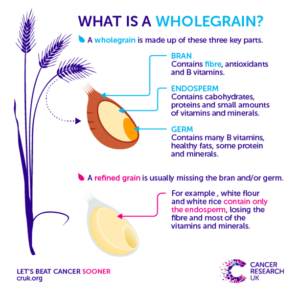
Figure 9: Explanation of wholegrain.
A study conducted by Cancer Research UK suggested that intake of whole grains in diet lowers the risk of bowel cancer. Dietary fiber could help protect against bowel cancer in a number of ways. Fiber increases the size of feces, dilutes their content and helps people get rid of waste more frequently thus reducing the time of harmful chemicals being in contact with the bowel. Furthermore, it assists gut bacteria to produce helpful chemicals that change the conditions in the bowel. All these things could reduce the risk of cancer. Phenolic acids found in wholegrain may also contribute to lowering the prevalence of disease. Consumption of 90g or 3 servings of whole grains eaten daily potentially reduces the risk by 17% for bowel cancer. Hence opting for whole grains at breakfast, consuming of popcorns instead of crisp and introducing brown rice and whole wheat pasta in diet can make a massive difference (Figure 10).
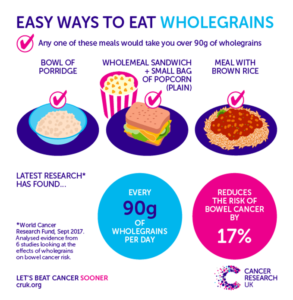
Herbs and Natural Products Protection against Cancer Growth

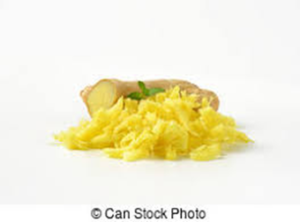

 Figure 11: Natural herbs.
Figure 11: Natural herbs.
Herbs are naturally rich in bioactive herbicetuicals that keep energy balance and provide substantial therapeutic value. They are rich in alkanoids, flavones, anti-oxidants, xanthones, omega 3 fatty acids, vitamin, minerals and fiber. Sometimes herbs are fortified with proteins and minerals. The active compound in herbs may be classified as isoprenoids derivates, phenolic compounds, carbohydrates and amino acid derivates, fatty acids, structural lipids and minerals (Figure 11).
- Ginger: It has properties of anti-platelets, anti-inflammatory, anti-oxidants, anti-arthritic and hypoglycemic effect. It helps to prevent cancer by having an inhibitory effect on angiogenesis and an inducing effect on apoptosis. An intake of 5-10grams of ginger is advised per day.
- Cinnamon: Contains anti-cancer, anti-microbial, anti-fungal and anti- diabetic properties.
- Green tea: High levels of antioxidants and some scientists believe that they may be the reason for the protective effect.
- Garlic: Garlic’s anti-cancer activity appears to stem from its allyl sulfur compounds and phytochemicals common to the allium family. Studies have suggested that garlic plays an important role in prevention of cancer. Garlic’s allyl sulfur compound is soluble in both water and oil. The compound possesses several properties and mechanism such as inhibiting enzymes that activate carcinogens, helping in DNA repair, slowing the growth stimulating self- destruction of cancer cells without disturbing normal cells, limiting cancer’s ability to spread by decreasing tumor’s ability to grow new blood vessels, boosts enzymes that detoxify carcinogens and activating tumor suppressing genes.
Guidelines for Cancer Prevention
- Maintain A Healthy Weight Throughout Life
>> Balance calorie intake with physical activity.
>> Avoid excessive weight gain throughout life.
>> Achieve and maintain a healthy weight if currently overweight and obese. - Adapt A Physically Active Lifestyle
>> Adults physical activity time………. 30 mins
>> Children and Adolescents …………. 60 mins - Eat A Healthy Diet With Emphasis On Plant Sources
>> Choose foods and drinks in amount that help and maintain a healthy weight.
>> Eat 5 or more servings of a variety of vegetables and fruits every day.
>> Choose whole grain over processed grains. - Limit Intake Of Processed And Red Meats
- Limit Intake Of Alcoholic Beverages
>> Women…………. 1 drink/per day
>> Men ………………. 2 drinks / per day
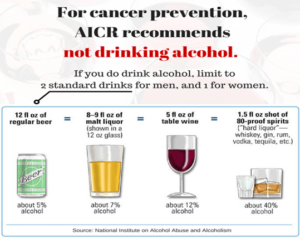
Figure 12: AICR recommendation for alcoholic beverages for cancer patient.

Figure 13: AICR sugar consumption.
Conclusion
Individuals with better quality of lifestyle, promoting healthy and well-balanced diet, higher levels of physical activity, reducing the amounts of alcohol, red and processed meat are at decreased risk of developing cancer. Although diet alone does not fully cure cancerous cells, medical care is an essential part for the treatment of disease. However, the best way to improve overall health is by correcting diet. At least half of all cancers are preventable by taking small simple steps.
References
- AICR's Foods That Fight Cancer™. (n.d.). Retrieved from https://www.aicr.org/foods-that-fight-cancer/apples.html
- AICR's Foods That Fight Cancer™. (n.d.). Retrieved from https://www.aicr.org/foods-that-fight-cancer/garlic.html
- AICR's Foods That Fight Cancer™. (n.d.). Retrieved from https://www.aicr.org/foods-that-fight-cancer/whole-grains.html
- AICR's Foods That Fight Cancer™. (n.d.). Retrieved from https://www.aicr.org/foods-that-fight-cancer/tomatoes.html
- Alcohol and cancer risk. (n.d.). Retrieved from https://www.aicr.org/reduce-your-cancer-risk/diet/alcohol-and-cancer-risk.html
- Axe, J. (2018, September 01). Cinnamon Health Benefits, Nutrition Facts and Side Effects. Retrieved from https://draxe.com/health-benefits-cinnamon/
- Broccoli linked to decreased risk of advanced prostate cancer. (2013, December 05). Retrieved from https://www.cancerresearchuk.org/about-us/cancer-news/news-report/2007-07-27-broccoli-linked-to-decreased-risk-of-advanced-prostate-cancer?_ga=2.238137664.1575608063.1555965595-2054877793.1538285961
- Can cancer be prevented? (2019, March 04). Retrieved from https://www.cancerresearchuk.org/about-cancer/causes-of-cancer/can-cancer-be-prevented
- (n.d.). Retrieved from https://www.who.int/en/news-room/fact-sheets/detail/cancer
- Cauliflower and broccoli boost cancer protection. (2017, November 03). Retrieved from https://www.cancerresearchuk.org/about-us/cancer-news/press-release/2006-02-07-cauliflower-and-broccoli-boost-cancer-protection
- Craig, & J, W. (1999, September 01). Health-promoting properties of common herbs. Retrieved from https://academic.oup.com/ajcn/article/70/3/491s/4714940
- Cruciferous Vegetables - Sulforaphane Prevents Cancer. (2017, October 28). Retrieved from https://juicing-for-health.com/cruciferous-vegetables
- Diet facts and evidence. (2019, March 04). Retrieved from https://www.cancerresearchuk.org/about-cancer/causes-of-cancer/diet-and-cancer/diet-facts-and-evidence#diet_facts1
- Eating organic food linked with lower cancer risk. (n.d.). Retrieved from https://www.nhs.uk/news/cancer/eating-organic-food-linked-lower-cancer-risk
- European Prospective Investigation into Cancer and Nutrition (EPIC). (n.d.).
Retrieved from http://epic.iarc.fr/research/nutrition.php#publication5
- Fiber lowering the risk of breast cancer in females. (n.d.).
Retrieved from https://www.nhs.uk/news/cancer/young-women-with-high-fibre-diet-may-have-lower-breast-cancer-risk - General cancer information. (2019, May 03). Retrieved from https://www.cancerresearchuk.org/about-cancer/cancer-in-general/treatment/complementary-alternative-therapies/individual-therapies/green-tea
- Hosseini, A., & Ghorbani, A. (2015). Cancer therapy with phytochemicals: Evidence from clinical studies. Retrieved from https://www.ncbi.nlm.nih.gov/pmc/articles/PMC4418057/
- How healthy eating prevents cancer. (2019, March 04).
Retrieved from https://www.cancerresearchuk.org/about-cancer/causes-of-cancer/diet-and-cancer/how-healthy-eating-prevents-cancer - How to enjoy a healthy diet. (2019, May 22). Retrieved from https://www.cancerresearchuk.org/about-cancer/causes-of-cancer/diet-and-cancer/how-to-enjoy-a-healthy-diet
- Increased fruit and vegetable consumption have 'small' impact on cancer prevention. (2013, December 16). Retrieved from https://www.cancerresearchuk.org/about-us/cancer-news/news-report/2010-04-08-increased-fruit-and-vegetable-consumption-has-small-impact-on-cancer-prevention
- Key statistics of WHO on cancer. (2012, February 03).
Retrieved from https://www.who.int/cancer/resources/keyfacts/en - De Laurentis M, Rossana B, Andrea B, Riccardo T, Valentina I (2018). The impact of social-emotional context in chronic cancer pain: Patient-caregiver reverberations. Supportive Care in Cancer,27: 705-713. doi:10.1007/s00520-018-4530-5
- Martinac, P. (2018, November 21). What Are the Benefits of Chewing Raw Garlic? Retrieved from https://healthyeating.sfgate.com/benefits-chewing-raw-garlic-3104.html
- Organic Ceremonial Grade Matcha Green Tea. (n.d.). Retrieved from http://www.getchia.com/organic-matcha-green-tea
- Organic Pomegranate White Tea. (n.d.). Retrieved from https://www.arborteas.com/organic-pomegranate-white-tea.html
- Phytochemicals: The Cancer Fighters in Your Foods. (n.d.). Retrieved from https://www.aicr.org/reduce-your-cancer-risk/diet/elements_phytochemicals.html
- Red and Processed Meats. (n.d.). Retrieved from https://www.aicr.org/reduce-your-cancer-risk/diet/red-and-processed-meat.html
- Schatzkin, Arthur, Mouw, Traci, F, A., Kipnis, . . . E, F. (2007, May 01). Dietary fiber and whole-grain consumption in relation to colorectal cancer in the NIH-AARP Diet and Health Study. Retrieved from https://academic.oup.com/ajcn/article/85/5/1353/4754401
- Southon, S., & Faulks, R. (2002). Health benefits of increased fruit and vegetable consumption. Fruit and Vegetable Processing. doi:10.1201/9781439823187.pt1
- Sugar and cancer risk. (n.d.). Retrieved from https://www.aicr.org/reduce-your-cancer-risk/diet/sugar-and-cancer-risk.html
- WWang H, Khor TO, Shu L, Su ZY, Fuentes F (2012). Plants vs. cancer: A review on natural phytochemicals in preventing and treating cancers and their drug ability. 12:1281-1305.
- What Is Cancer? (n.d.). Retrieved from https://www.cancer.gov/about-cancer/understanding/what-is-cancer
- Whole and Grated Ginger Root. (n.d.).
Retrieved from https://www.canstockphoto.com/whole-and-grated-ginger-root-38980808.html - Wholegrains and bowel cancer–what you need to know. (n.d.).
Retrieved from https://scienceblog.cancerresearchuk.org/2017/09/08/wholegrains-and-bowel-cancer-what-you-need-to-know/